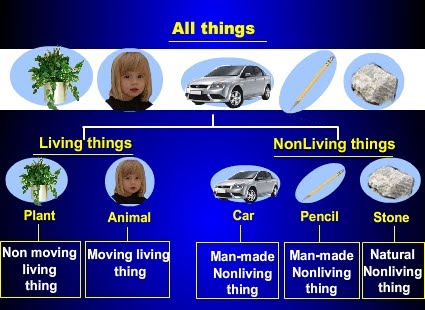Living Things
We are surrounded by living and non-living things. All animals and plants are living things and biology is the study of these living things. A cat playing with a ball is obviously living. A pigeon flying from tree to tree is also a living thing.
Sometimes it is not so easy to decide. Plants are living things but they do not play with balls or fly. If something is living it will carry out all of the seven activities shown opposite.
Some non-living things show one or two of the seven characteristics of living things. Machines, such as washing machines, can move. The car needs to be fed with petrol in order to move.
Crystals, such as ice crystals forming on a window, grow bigger if the conditions are right. For something to be living it has to show all of the seven characteristics of living things.
Non-living things
Sand, wood and glass are all non-living things. None of them shows any of the characteristics listed above. Non-living things can be divided into two groups. First, come those which were never part of a living thing, such as stone and gold.
The second group are those which were once part of living things. Coal is a good example. It was formed when trees died and sank into the soft ground. This happened many millions of years ago when the Earth was covered with forests. Paper is non-living but it is also made from trees. Jam is also non-living but it was made from the fruit of a plant.
The Seven Characteristics of Living Things
Feeding
All living organisms need to take substances from their environment to obtain energy, to grow and to stay healthy.
Movement
All living organisms show movement of one kind or another. All living organisms have internal movement, which means that they have the ability of moving substances from one part of their body to another. Some living organisms show external movement as well - they can move from place to place by walking, flying or swimming.
Breathing or Respiration
All living things exchange gases with their environment. Animals take in oxygen and breathe out carbon dioxide.
Excretion
Excretion is the removal of waste from the body. If this waste was allowed to remain in the body it could be poisonous. Humans produce a liquid waste called urine. We also excrete waste when we breathe out. All living things need to remove waste from their bodies.
Growth
When living things feed they gain energy. Some of this energy is used in growth. Living things become larger and more complicated as they grow.
Sensitivity
Living things react to changes around them. We react to touch, light, heat, cold and sound, as do other living things.
Reproduction
All living things produce young. Humans make babies, cats produce kittens and pigeons lay eggs. Plants also reproduce. Many make seeds which can germinate and grow into new plants.



No comments:
Post a Comment